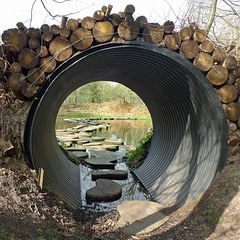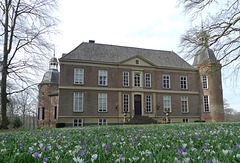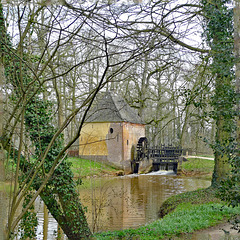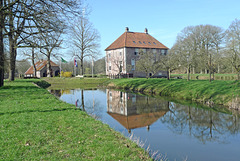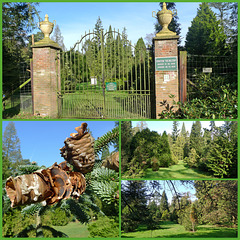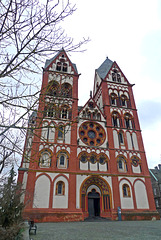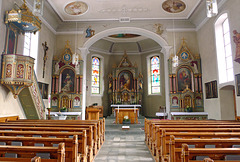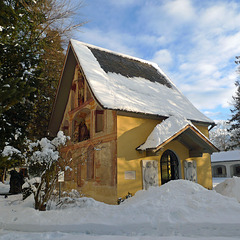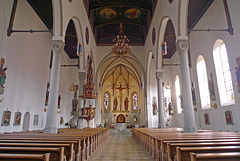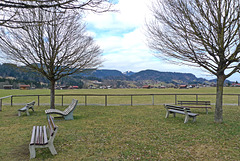Jaap van 't Veen's photos
Nederland - Apeldoorn, Paleispark
| |
|
|
|
The Paleispark (Palace Park) is a part of Kroondomein Het Loo (Het Loo Royal Estate). With an area of 650 hectare the park is ideal for strolling and walking. It lies adjacent to “Het Loo Palace” and around Castle Het Oude Loo . Traditionally this park was for the relaxation of the royal residents of the palace. and their guests.
The origins of the park can be traced back to stadtholder Willem III, who purchased hunting lodge Het Oude Loo in 1684 together with 200 hectare land. “Het Loo Royal Estate” was also very important for Queen Wilhelmina. She purchased many acres of land and donated this to the State in 1959, retaining the rights of usage for the reigning monarch. This explains the name for the whole area: “Het Loo Royal Estate”.
The palace park is only a small part of “Het Loo Royal Estate”. The park features ponds, a tea pavilion (main image and PiP1), which was often used by Queen Wilhelmina, a bath-house (PiP2), a royal horse cemetery, an old shooting range, a hunting lodge and several follies. The park is open - against a small fee - the whole year round, the part around Het Oude Loo is open for visitors only during the months April and May.
Nederland - Haaksbergen, Het Lankheet
| |
|
|
|
Het Lankheet is an estate south of Haaksbergen. The family estate is approx. 500 hectares in size and has an alternation of forest, agriculture, heathland and fens.
The history of this estate goes back 800 years, but they also look ahead - well into the 21st century. There are various contemporary landscape projects on display in the areas of water purification, energy extraction, multifunctional climate forests, timber cultivation, youth education and youth care, art and theater.
A notable part of the waterpark in Het Lankheet are the “Kidney Pools”: two kidney-shaped, interlocking ponds like yin and yang: symbols of purification, but also of balanced proportions. A path of stepping stones allows people to walk through the two ponds. Apart from being a place of meditation, the “Kidney Pools” are also a place of entertainment for young and old.
Nederland - Vorden, Kasteel Hackfort
| |
|
|
|
The earliest known history of Kasteel Hackfort (Hackfort Castle) is dating back to the year of 1324, when the Lord of Bronckhorst commissioned the building of a castle. In 1392 ‘House Hacforden’ was nothing more than just a residential tower and a moat. In 1586 the castle was destroyed by the Spanish troops during the Eighty Year's War (the Dutch Independent War). After the liberation of the region by Prince Maurits van Oranje, the castle was rebuilt in 1598 by Borchard van Westerholt.
In 1788, Kasteel Hackfort underwent substantial renovations. The old gate house and outbuildings were demolished and the canals were filled in. The castle was transformed into an 18th-century manor house. Nowadays only the two thick cylindrical towers are reminders of the (former) castle. The castle is surrounded by forests and meadows and includes Hackfort Watermill .
The castle remained for centuries in the possession of the family Van Westerholt. When the last Baroness Westerholt of Hackfort died in1981, Kasteel Hackfort and estate were donated to Natuurmonumenten (a Dutch society for preservation of nature monuments).
Nederland - Vorden, Watermolen Hackfort
| |
|
|
|
The Watermolen Hackfort (Hackfort Watermill) is located on the estate Hackfort , close to the castle of the same name. The undershot watermill was first mentioned in the year 1442, while the current square stone building was built around 1700. The mill is equipped with a water wheel with blades and is powered by water from the Hackfortse Beek. The water wheel drives millstones to grind grain. The water mill also supplies electricity to the electricity network.
In 1952 the mill was shut down due to the poor condition of the wheel and building. At that time the stream also contained too little water to power the mill. In 1981, the estate (with castle and mill) came into the hands of the Natuurmonumenten (a Dutch society for preservation of nature monuments) and was refurbished. After the water board had ensured that sufficient water flowed through the Hackfortse Beek, a new water wheel was installed in 1998.
Since that moment the mill has been in use. Volunteer millers are sawing wood and grinding grain for cattle feed on hydropower. On Saturdays and on special occasions the mill is open to visitors.
Nederland - Haaksbergen, Oostendorper watermolen
| |
|
|
|
The oldest written mention of the Oostendorper watermolen (Oostendorp watermill) - a corn and oil mill on the Buurserbeek - is found in a deed from 1487. The mill was then located about 1 km downstream. In 1547-1548, the double mill was rebuilt at its current location. It also received its current name then, which comes from Johan ten Oostendorp who was the miller in 1547.
During the Eighty Years' War (1566 - 1648), the water mill was destroyed. In 1633, Willem Ripperda tot Weldam received permission to build the Oostendorper mill on the current site. Two years later, the mills were back in operation. During the next two centuries, they passed from one owner to another several times, by inheritance or by sale.
In 1946, a flood of water washed away the oil mill; it had been rebuilt four years later. In the late 1980s, the Oostendorper watermolen was thoroughly restored and made millable again. Volunteer millers regularly grind grain and crush oil. The municipality of Haaksbergen owns the mill. It is the oldest double water mill in the Netherlands.
Nederland - Neede, Havezathe de Kamp
| |
|
|
|
Over the past centuries Havezathe de Kamp (havezathe = manor or fortified (farm) house) has been rebuilt and renovated several times. In 1782 the stepped gables disappeared and in 1871 the canal was filled in and “De Kamp” lost its castle-like appearance.
“Huis De Camp” - as it was originally called - was probably built in the 13th century. In 1469 Johan Van Barmentloo was the first resident whose name we know. In 1553 the house came into the hands of the Gansneb family called Tengnagel. Several generations continued to live there for almost two hundred years. In 1636, Otto Gansneb had Havezathe de Kamp raised and rebuilt into the building as it looks today. The manor was sold in 1741 and subsequently had various owners.
In 1977 the house came into the possession of the municipality of Neede (later Berkelland). Between 1983 and 1989 the manor was restored, the canal was dug out again and the coach house was rebuilt. In 2014, “De Kamp” came into the possession of private owners
After the re-excavation of the moat and the most recent alterations and renovations, Havezathe de Kamp has regained its authentic appearance. Nowadays it is used for business/private meetings and events.
Nederland - Vorden, Pinetum de Belten
| |
|
|
|
Pinetum de Belten is an arboretum with only conifers. This pinetum was founded by Squire Mr. P.R Feith in 1961, when he started collecting pine-trees from all over the world.
Pinetum de Belten is grown from the start to 1400 different types of pine trees. Due to lack of space for so many trees in 1992 the decision was made at around 700 trees to be grubbed up. Sub-tropical trees are removed out of the collection.Nowadayas there are more than 1000 different kinds of trees. Species must be able to grow in this environment. A single exception is made for unique items of the collection.
Since 1974 the pinetum is managed by a foundation. The main goal is to maintain and care for the collection of pine trees. Pinetum de Belten is free to visit, although a voluntary donation is very welcome.
Germany - Limburg an der Lahn
| |
|
|
|
Limburg - developed around a castle from the late 7th century - was first mentioned in documents in the year of 910 as "Lintpurc", when the St. George monastery was founded by Konrad Kurzbold. The town became stone ramparts in the 12th and following centuries. The construction of a new church belonging to St. George monastery started in 1200. Around that time a new castle was built south of the new church.
The plague ravaged Limburg in 1344. The town then underwent a steady decline until the early 19th century, when the rise of the Duchy of Nassau (1806-1866) gave a new lease of life to Limburg. In 1827, Limburg became the seat of a diocese and in 1886 it was made district capital.
Nowadays Limburg's old town offers a maze of cobble stoned streets, lined with crooked half-timbered houses some dating back to the 13th century, but most of them are ‘just’ from the 17th or 18th century.
Germany - Limburg an der Lahn, Limburger Dom
| |
|
|
|
The Limburger Dom (Limburg Cathedral) also known as Georgsdom (George's Cathedral> is one of the best preserved late Romanesque style buildings in Germany. It is unknown when the first church was built on a hill above the Lahn river. Archaeological discoveries have revealed traces of a 9th-century church building in the area of the current chapel. It was probably built in Merovingian times as a castle and the chapel added in the early 9th century.
In 910 AD, Count Konrad Kurzbold founded a collegiate chapter of 18 canons, who lived on the hilltop site. The original castle chapel was torn down and a three-aisled church was built in its place; its foundations have been found beneath the present floor.
The construction of current cathedral is dated to 1180-90. The consecration was performed in 1235 by the archbishop of Trier. Most probably the cathedral was built in four stages. In reference to the seven sacraments, the cathedral also has seven towers.
The interior was destroyed by Swedish soldiers during the Thirty Years War (1618-48) and reconstructed in a late Baroque style in 1749. The church became the rank of cathedral in 1827 when the bishopric of Limburg was founded. In- and exterior have been renovated and restored acouple of times; the last renovation was in the 1980s.
Germany - Weingarten, Basilika St. Martin und Oswa…
| |
|
|
|
The Basilica, which towers on the Martinsberg, is the landmark of Weingarten and the largest baroque church north of the Alps and the second largest church in Germany after the Cathedral of Cologne. It is sometimes called the "Swabian St. Peter's", designed to be one-half the size of the Vatican’s St. Peter's Basilica in Rome.
The Basilica of Weingarten - dedicated to the patron saint of Weingarten, Saint Martin - is an impressive structure that dominates the skyline of Weingarten. The Basilica offers a magnificent baroque architecture and is considered one of the most immaculate examples of baroque buildings in Germany. The interior of the Basilica is as splendid as the exterior, with stunning woodwork and sculptures adorning every corner of the church. The present church was built between 1715 and 1724 in the Italian-German baroque style from architectural plans by Franz Beer.
Austria - Kleinwalsertal/Riezlern, Mariä Opferung
| |
|
|
|
The parish church Mariä Opferung (also called Meine liebe Frau von Jerusalem ) is dating back to the year 1471, visible in the vestibule of the church. In 1493, a gothic-style church was inaugurated and a cemetery was built.
The church was extended in the years1684 and 1720. The tower was raised in 1844 and the pitched roof replaced by a dome. In 1889 the dilapidated church including the tower was demolished and a new, built in the neo-Romanesque style. The ‘new’ church was completed in 1894 and the inauguration took place on June 12 of that year.
Martin von Feuerstein, a well-known Munich professor, created the splendid paintings in casein technique in 1903/1904 with his master class. Twenty years later the Mariä Opferung became a new altar.
Austria - Kleinwalsertal/Hirschegg, Hl. Mutter Ann…
| |
|
|
|
The history of Hl. Mutter Anna (St. Anna parish church) dates back to around 1570, when in Hirschegg a chapel is mentioned, which was then changed and rebuilt several times. The first time the place name was mentioned in the annual diary 1499, where it is recorded in a document: “... located on the hierßegg, dz. picture dar”. As "image" is a shrine or a small chapel to understand.
In 1745 Hirschegg was raised to the chaplaincy. The maternal priest Mittelberg originally filed vehement opposition. Ultimately, the bishop of Constance decided that the pastor has to recognize the appointment of a curate. In 1767 the chapel received a new tower. In 1782 the Hirschegger asked for release from the parish of Mittelberg; ten years later the elevation to an independent parish took place. In 1804, the foundation stone was laid for rebuilding the church. In 1806, the present church was inaugurated by the Bishop of Constance.
Germany - Oberstdorf, Seelenkapelle
| |
|
|
|
The Seelenkapelle (Chapel of the Souls) is one of the few buildings in the center of Oberstdirf, which did not fall victim to the Great Fire of 1865. The chapel is located on the west side of the parish church - in the middle of the old abandoned cemetery - and has been used as a war memorial chapel since 1931. The entrance is therefore guarded by two martial soldiers.
The chapel was probably built in the late 15th century. An "eternal light" was donated to it in 1504. In 1524 it was mentioned as an ossuary. The amazing paintings with the sculptures in the niches on the north wall were created in the middle of the 16th century. The impressive Pietà in the interior is dating back to the early 40s of the 20th century.
The Seelenkapelle is of huge significance to the fallen soldiers from the war and is also considered as a memorial (PiP3). The chapel is the second oldest of the Oberstdorf chapels.
Germany - Rettenberg, Geratser Wasserfall
| |
|
|
|
The Geratser Wasserfall is a striking waterfall in the Kranzegger Bach . It is located south of Kempten and north of Sonthofen in the municipality of Rettenberg. The Kranzegger Bach flows through a green meadow landscape before dropping six meters from a wall in a small wooded area.
The waterfall got its name from the hamlet of Gerats, where it is located. As the waterfall is so hidden in the forest and at the same time a few kilometers away from well known villages, this natural wonder does not attract many visitors.
Germany - Oberstaufen, St. Peter und Paul
| |
|
|
|
The St. Peter und Paul - the catholic parish church of Oberstaufen - was built in 1389 on the ruins of a medieval collegiate church. In its turbulent past, the church saw further destruction when it fell victim to fire at the end of the 17th century and in the 19th century. The present church was built in the neo-Gothic style between 1859 and 1863.
The St. Peter und Paul impresses with a 65 meters high tower with foundations dating back to the 13th century, meter-high statues of the crucifixion group from the late Gothic period and a huge image of St. Christopher on the façade. The ornate pulpit inside the church was also built in the neo-Gothic style in the mid-19th century.
Germany - Oberstdorf, St. Johannes Baptist
| |
|
|
|
St. Johannes Baptist - the parish church of Oberstdorf - stands on the market square in the center of town. The tower with a height of 66 meters - the tallest in the upper Illertal - is the landmark of the town.
The year 991 is mentioned in chronicles as the start of construction of the parish church, but other sources report that this Romanesque church was consecrated in 1141. In 1865, two thirds of Oberstdorf fell victim to the the great fire, including the parish church in the middle of the village; only the surrounding walls and the burnt-out tower remained standing.
The reconstruction of the parish church took place in 1866. The walls of the nave, which were still standing and made of stone masonry could be used again; the nave was raised, extended and provided with a newly built choir. The church was finally reconsecrated in 1872.
Four altars, beautiful pictures and statues adorn the church. The high altar and the people's altar are in the choir room. On the left is the Pentecost altar and on the right the Christmas altar. The church also has a beautiful carved pulpit.
Germany - Oberstdorf, Breitachklamm
| |
|
|
|
The Breitachklamm (Breitach Gorge) was formed only during the last 10,000 years after the “Würm ice age”. Glaciers had eroded soft rocks, and hard rocks remained. When the glaciers had melted, the river Breitach had to grind its way through the hard rocks, over a distance of 2.5 km.
During these years the Breitach has cut a deep canyon into the rocks of the Bavarian Alps, almost on the border between Austria and Germany, just south of Oberstdorf. The most interesting part of the gorge is a couple of hundred meters long. On some places the steep walls are more than 100 meters high, where only very few spots ever get the sunlight.
There is a secured path along the river, which on the narrowest places has been cut into the steep wall of the canyon. All around is water running down the rocks, gurgles in tiny rivers across the hiking trail into the Breitach. On other place waterfalls are coming down from the overhanging walls. The further you enter the gorge, the scene turns into barren rocks with the noise of the powerful water rushing and tumbling metres below the walkway.
Winter 2024 Oberstdorf: Unlike on a previous winter-visit when the walls of the gorge were covered with glittering icicles, ice curtains and frozen waterfalls we were now surprised by waterfalls and a spray of fine droplets and the roaring Breitach beneath us. Water was really everywhere.
Germany - Oberstdorf
| |
|
|
|
The huge village meadow - Öschwiesen - of Oberstdorf is dotted with old barns. Being as flat as a pancake it is an ideal place for walking, biking and in winter for cross country skiing.
Winter 2024 Oberstdorf: No snow, no cross-country skiing, just walkers enjoying the sun and/or the magnificent views of the surrounding Allgäu mountains (snow picture see PiP3). Farmers had already spread manure on the pastures.
Jump to top
- ipernity © 2007-2024
- Help & Contact
|
Club news
|
About ipernity
|
History |
ipernity Club & Prices |
Guide of good conduct
Donate | Group guidelines | Privacy policy | Terms of use | Statutes | In memoria -
Facebook
Twitter


